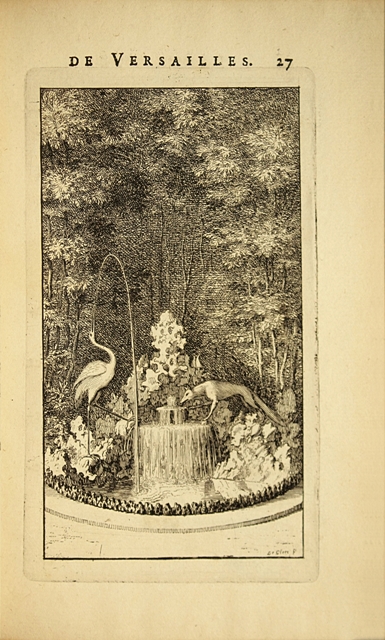Paris, Imprimerie royale, 1677.
Small 4to [197 x 128 mm] of 34 preliminary pp., (1) l., 1 map out of pagination, 79 pp. including 40 plates in the text, (2) ll. Full red morocco, triple gilt fillet on the covers with corner fleurons in the style of Duseuil, spine ribbed and decorated with gilt fleurons, inner gilt border, gilt over marbled edges. Binding signed Trautz-Bauzonnet.
First edition of this refined collection gathering Charles Perrault’s text dedicated to the description of the labyrinth of Versailles with 40 fine engravings by Sébastien Le Clerc, depicting in first state the copses and fountains with animal patterns. Tchemerzine, V, 165.
Louis XIV definitely settled down in Versailles on May 6th, 1682, which then became the capital of the kingdom. André Le Nôtre (1613-1700), who had just distinguished himself in Vaux le Victome, had developed a sumptuous garden where sculptures wonderfully matched the numerous ponds and fountains.
The green labyrinth fully evoked this novelty of drawing and this care for elegance animating the artistes hired by Louis XIV for the sumptuous construction of the castle and the garden.
Charles Perrault started the description of the labyrinth in this compilation made for the King’s cabinet. “There is no turn that doesn’t show several fountains at the same time in sight in such a way that at êch step we are surprised by something new”.
While evoking the subject of êch of the 38 Aesop’s Fables from which the artists took their inspiration, Charles Perrault gives a picturesque description of the Fountains. “In a treillis cabinet, with architecture, is a round pond, in the middle of which the kite with the doves it keeps under its claws, forms a sort of spray all around the ledge of the cabinet…”.
The text of this volume had alrêdy been published in the compilation of various works by Perrault published in 1675. It occupies here the 34 first pages of the compilation.
On the opposite page of êch of the fountains and copses engravings by Sébastien Leclerc, here in first state, is printed a quatrain by Bensérade briskly portraying the pictured fable.
An elegant copy finely bound in red morocco binding in the style of Duseuil by Trautz-Bauzonnet.
Provenance: Collection of Mr. G. Chartener with engraved ex-libris, unidentified interlaced initials stamped on an endlêf.
See less information





